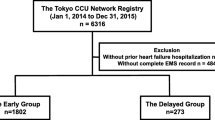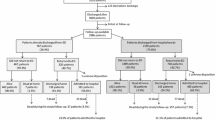Abstract
Background
Increased length of stay (LOS) during acute heart failure (HF) hospitalization is associated with readmission and mortality.
Methods
The ESCAPE trial data were utilized to identify determinants and post-discharge outcomes of patients with acute systolic HF requiring longer-than-average LOS (≥7 days). The study endpoints were 6‑month all-cause mortality, all-cause rehospitalization, and the composite endpoint of death, cardiac rehospitalization, and cardiac transplant.
Results
Among the 424 patients with recorded LOS, 216 (50.9%) and 208 (49.1%) had LOS ≥ or <7 days, respectively. Independent determinants of longer-than-average LOS included older age (OR per 10-year increase: 1.759, 95% CI: 1.120–2.763, p = 0.014), higher blood urea nitrogen (OR per 5 mg/dl increase: 1.202, 95% CI: 1.024–1.410, p = 0.024), greater inferior vena cava diameter (OR per 1 cm increase: 2.453, 95% CI: 1.175–5.121, p = 0.017), and lower sodium (OR per 4 mmol/l increase: 0.494, 95% CI: 0.268–0.911, p = 0.024). We found a significant correlation between right-sided failure (right atrial pressure) and LOS (r = 0.229, p = 0.001) but not left-sided failure (pulmonary capillary wedge pressure, r = 0.099, p = 0.177). Patients with longer-than-average LOS had a significantly higher mortality (25.9% vs. 12%, univariate OR: 2.562, 95% CI: 1.528–4.296, p < 0.001), higher all-cause rehospitalization (63% vs. 53.4%, univariate OR: 1.486, 95% CI: 1.008–2.190, p = 0.046) and higher frequency of the composite endpoint of death, cardiac rehospitalization, and cardiac transplant (61.6% vs. 45.2%, univariate OR: 1.943, 95% CI: 1.320–2.862, p = 0.001) compared with an LOS of <7 days. Cox proportional hazard analysis showed that a longer-than-average LOS was an independent predictor of 6‑month all-cause mortality (HR: 1.930, 95% CI: 1.112–3.350, p = 0.019).
Conclusion
In acute HF, right ventricular failure and renal dysfunction predict longer-than-average LOS, which is a proxy for more severe HF and is associated with worse postdischarge outcomes.
Zusammenfassung
Hintergrund
Die Verweildauer im Krankenhaus („length of stay“, LOS) bei akuter Herzinsuffizienz ist mit Rehospitalisierung und Mortalität verknüpft.
Methoden
Anhand der Daten der ESCAPE-Studie wurden Einflussfaktoren und Ergebnisse nach Entlassung von Patienten ermittelt, bei denen eine überdurchschnittlich lange LOS (≥7 Tage) wegen akuter systolischer HF erforderlich war. Studienendpunkte waren die 6‑Monats-Gesamtmortalität und der zusammengesetzte Endpunkt aus Tod, kardial bedingter Wiederaufnahme und Herztransplantation.
Ergebnisse
Von den 424 Patienten mit dokumentierter LOS betrug diese bei 216 (50,9%) ≥7 bzw. bei 208 (49,1%) <7 Tage. Zu den unabhängigen Faktoren einer überdurchschnittlichen LOS gehörten höheres Alter (Odds Ratio (OR) pro 10-Jahres-Anstieg: 1,759; 95%-Konfidenzintervall (95%-KI): 1,120–2,763; p = 0,014), höhere Blut-Harnstoff-Stickstoff-Werte (OR pro Anstieg um 5 mg/dl: 1,202; 95%-KI: 1,024–1,410; p = 0,024), größerer Durchmesser der V. cava inferior (OR pro Anstieg um 1 cm: 2,453; 95%-KI: 1,175–5,121; p = 0,017) und niedrigere Na-Werte (OR pro Anstieg um 4 mmol/l: 0,494; 95%-KI: 0,268–0,911; p = 0,024). Es stellte sich eine signifikante Korrelation zwischen Rechtherzinsuffizienz (rechter Vorhofdruck) und LOS heraus (r = 0,229; p = 0,001), nicht aber für Linksherzinsuffizienz (pulmonalkapillärer Verschlussdruck, r = 0,099; p = 0,177). Bei Patienten mit überdurchschnittlicher LOS fand sich eine signifikant höhere Mortalität (25,9% vs. 12%, univariate OR: 2,562, 95%-KI: 1,528–4,296, p < 0,001), höhere Rehospitalisierung jeglicher Ursache (63% vs. 53,4%, univariate OR: 1,486, 95%-KI: 1,008–2,190, p = 0,046) und höhere Häufigkeit des zusammengesetzten Endpunkts aus Tod, kardial bedingter Wiederaufnahme und Herztransplantation (61,6% vs. 45,2%; univariate OR: 1,943; 95%-KI: 1,320–2,862; p = 0,001) gegenüber einer LOS <7 Tage. Die Proportional-Hazard-Analyse nach Cox zeigte, dass eine überdurchschnittliche LOS einen unabhängigen Prädiktor der 6‑Monats-Gesamtmortalität darstellte (Hazard Ratio: 1,930; 95%-KI: 1,112–3,350; p = 0,019).
Schlussfolgerung
Bei akuter Herzinsuffizienz dienen Zeichen der Rechtsherzinsuffizienz und der Nierenfunktionsstörung als Prädiktor einer überdurchschnittlichen LOS. Letztere stellt einen Ersatzparameter für eine schwerere Herzinsuffizienz dar und geht mit schlechteren Ergebnissen nach Entlassung aus dem Krankenhaus einher.




Similar content being viewed by others
References
Gheorghiade M et al (2013) Rehospitalization for heart failure: problems and perspectives. J Am Coll Cardiol 61(4):391–403
Heidenreich PA et al (2013) Forecasting the impact of heart failure in the United States: a policy statement from the American Heart Association. Circ Heart Fail 6(3):606–619
Dunlay SM et al (2011) Lifetime costs of medical care after heart failure diagnosis. Circ Cardiovasc Qual Outcomes 4(1):68–75
Hunt SA et al (2009) Focused update incorporated into the ACC/AHA 2005 guidelines for the diagnosis and management of heart failure in adults a report of the American College of Cardiology Foundation/American Heart Association task force on practice guidelines developed in collaboration with the International Society for Heart and Lung Transplantation. J Am Coll Cardiol 53(15):e1–e90
Krumholz HM et al (2009) Patterns of hospital performance in acute myocardial infarction and heart failure 30-day mortality and readmission. Circ Cardiovasc Qual Outcomes 2(5):407–413
Chun S et al (2012) Lifetime analysis of hospitalizations and survival of patients newly admitted with heart failure. Circ Heart Fail 5(4):414–421
Solomon SD et al (2007) Influence of nonfatal hospitalization for heart failure on subsequent mortality in patients with chronic heart failure. Circulation 116(13):1482–1487
Ahmed A et al (2008) Incident heart failure hospitalization and subsequent mortality in chronic heart failure: a propensity-matched study. J Card Fail 14(3):211–218
Reynolds K et al (2015) Relation of acute heart failure hospital length of stay to subsequent readmission and all-cause mortality. Am J Cardiol 116(3):400–405
Cotter G et al (2016) Predictors and associations with outcomes of length of hospital stay in patients with acute heart failure: results from VERITAS. J Card Fail 22:815–822. doi:10.1016/j.cardfail.2015.12.017
Shah MR et al (2001) Hemodynamic profiles of advanced heart failure: association with clinical characteristics and long-term outcomes. J Card Fail 7(2):105–113
Binanay C et al (2005) Evaluation study of congestive heart failure and pulmonary artery catheterization effectiveness: the ESCAPE trial. JAMA 294(13):1625–1633
Wright SP et al (2003) Factors influencing the length of hospital stay of patients with heart failure. Eur J Heart Fail 5(2):201–209
Adams KF Jr. et al (2005) Characteristics and outcomes of patients hospitalized for heart failure in the United States: rationale, design, and preliminary observations from the first 100,000 cases in the Acute Decompensated Heart Failure National Registry (ADHERE). Am Heart J 149(2):209–216
Chen J et al (2013) National trends in heart failure hospital stay rates, 2001 to 2009. J Am Coll Cardiol 61(10):1078–1088
Cotter G et al (2016) Predictors and associations with outcomes of length of hospital stay in patients with acute heart failure: results from VERITAS. J Card Fail 22(10):815–822
Formiga F et al (2008) Admission characteristics predicting longer length of stay among elderly patients hospitalized for decompensated heart failure. Eur J Intern Med 19(3):198–202
Omar HR, Guglin M (2016) Characteristics and outcomes of patients with acute systolic heart failure discharged within 48hours: a qualification for “observation status” hospital admission. Int J Cardiol 223:129–132
Carr JG et al (1989) Prevalence and hemodynamic correlates of malnutrition in severe congestive heart failure secondary to ischemic or idiopathic dilated cardiomyopathy. Am J Cardiol 63(11):709–713
Ghio S et al (2001) Independent and additive prognostic value of right ventricular systolic function and pulmonary artery pressure in patients with chronic heart failure. J Am Coll Cardiol 37(1):183–188
Acknowledgements
The ESCAPE trial was conducted and supported by the NHLBI in collaboration with the ESCAPE study investigators. This article was prepared using a limited access dataset obtained from the NHLBI and does not necessarily reflect the opinions or views of the ESCAPE trial investigators or the NHLBI.
Author information
Authors and Affiliations
Corresponding author
Ethics declarations
Conflict of interest
H.R. Omar and M. Guglin declare that they have no competing interests.
This article does not contain any studies with human participants or animals performed by any of the authors.
Rights and permissions
About this article
Cite this article
Omar, H.R., Guglin, M. Longer-than-average length of stay in acute heart failure. Herz 43, 131–139 (2018). https://doi.org/10.1007/s00059-016-4532-3
Received:
Revised:
Accepted:
Published:
Issue Date:
DOI: https://doi.org/10.1007/s00059-016-4532-3




